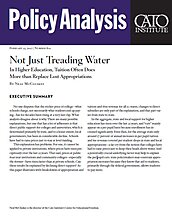This explanation has problems. For one, it cannot be applied to private institutions, where prices have risen precipitously over the last 25 years. That said, prices at public four-year institutions and community colleges—especially the former—have risen faster than at private schools. Can these results be explained by declining direct support? As this paper illustrates with breakdowns of appropriation and tuition-and-fee revenue for all 50 states, changes to direct subsidies are only part of the explanation, and that part varies from state to state.
In the aggregate, state and local support for higher education has risen over the last 25 years, and “cuts” mainly appear on a per pupil basis because enrollment has increased significantly. Even then, for the average state only around 57 percent of annual increases in per pupil tuition and fee revenue covered per student drops in state and local appropriations—a far cry from the notion that colleges have had to raise prices just to keep their heads above water. And a potentially crucial underlying factor may help to explain the per pupil cuts: state policymakers may constrain appropriation increases because they know that aid to students, primarily through the federal government, allows students to pay more.


